Along with trying out different cars, one of the goals of my Summer Road Trip was sampling series all across the participation spectrum. I’ve certainly done that so far, going from round-the-clock multi-split series like the Global Mazda Cup and GT3s to the league-like atmosphere of the planned American-friendly timeslots for the Grand Touring Cup and V8 Supercars.
When it comes to participation, though, nothing prepared me for what awaited in the Radical Racing Challenge.
I found a series that only had 14 official races through the first eight weeks of the season. One week — round 6 at Mid-Ohio — had no official races at all, and just one race all season has had more than 10 drivers, when 17 people showed up for a Friday afternoon race two weeks ago.
Although prior to last week, I had never raced the sleek, open-topped prototype that is the Radical SR8, I certainly didn’t expect its numbers to be that bad. While I knew it had something of a niche following, most of the people I know that have driven it over the years have had nothing but good things to say about it, so I figured it would at least have a decent-sized following.
As I arrived on the scene of this barely-breathing series in week 9, my objective turned from just trying the car for myself to assessing the dire situation and what’s being done — if anything — to keep the series alive.
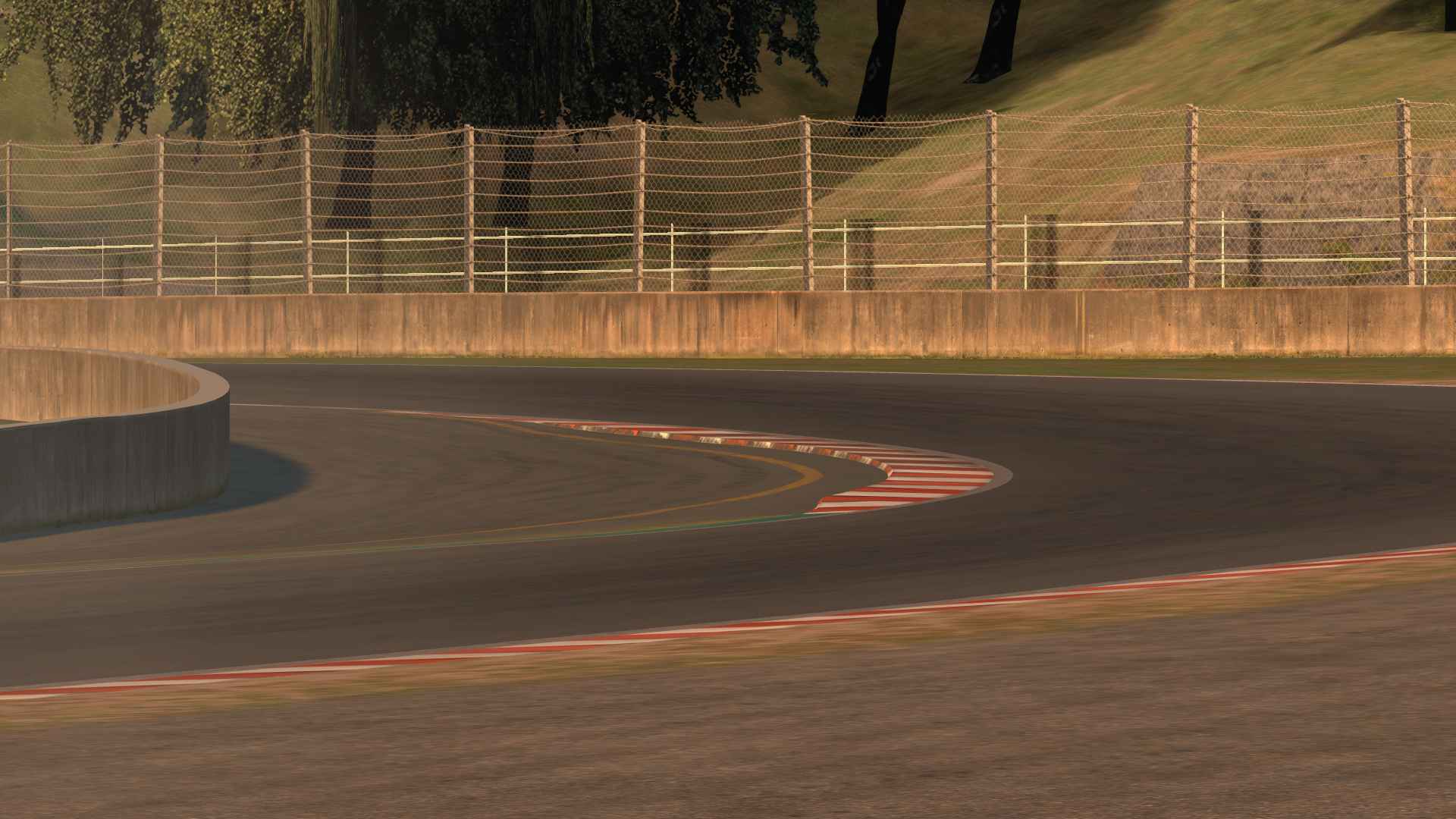
An empty track at race time — a sadly common sight in the Radical Racing Challenge.
The Few, the Proud
While I expected this struggling series to have a nearly dead community surrounding it, I was surprised to find a small but active group of drivers discussing it on the iRacing forums.
Just like the big multi-split series, weekly race threads are posted including setups, and discussions are ongoing about the car, the series, and the future.
Likewise, I expected a lot of pessimism and closed-mindedness. After all, the final few passengers on a sinking ship rarely consider how their life could soon get better.
But I was wrong again about that. The Radical community is considering all options for improving things, from the setup to the schedule to potentially merging it into a multi-class series with another car.
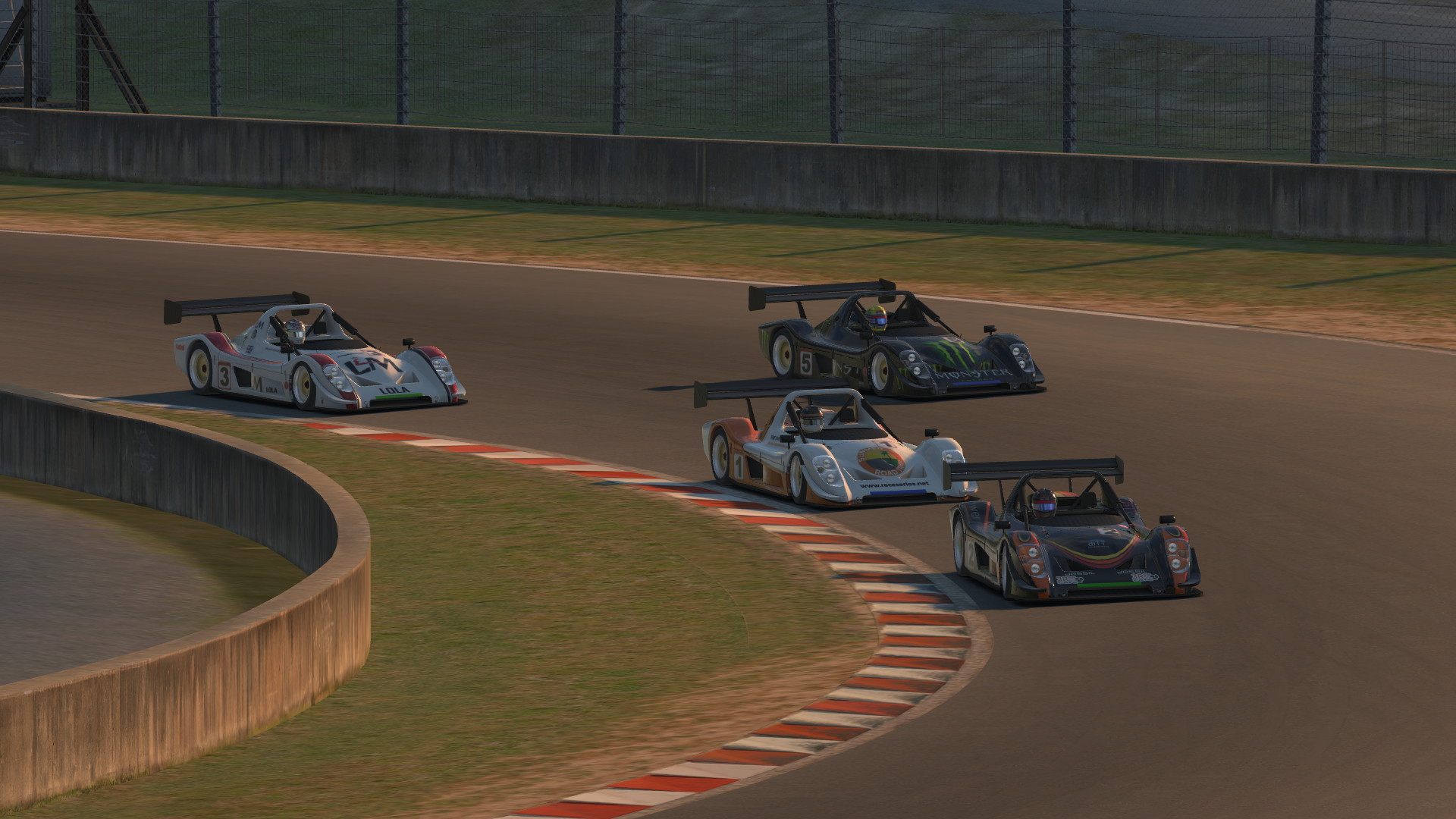
The front of the field heads through turn 1 at Okayama.
While the latest idea to combine it with the Spec Racer Ford — the next vehicle on my Road Trip — has been shot down by the community, a similar deal has been done before. From mid-2015 through mid-2016, the Radical and HPD ARX-01c competed in separate classes within the Prototype Challenge series. The Radical’s participation still wasn’t great, but at least more races went official thanks to the influx of HPD drivers.
For the current season, the Radical community went with a schedule of shorter track configurations, like last week’s venue at the Okayama short circuit, where my lap times were under 50 seconds. They also opted to put all races in morning conditions, which makes the track cooler and the car a bit easier to drive.
The community, it seems, has done just about everything right to prime the series for participation. Short of actually driving the car for people, it’s hard to imagine them doing much more.
So where are the drivers?
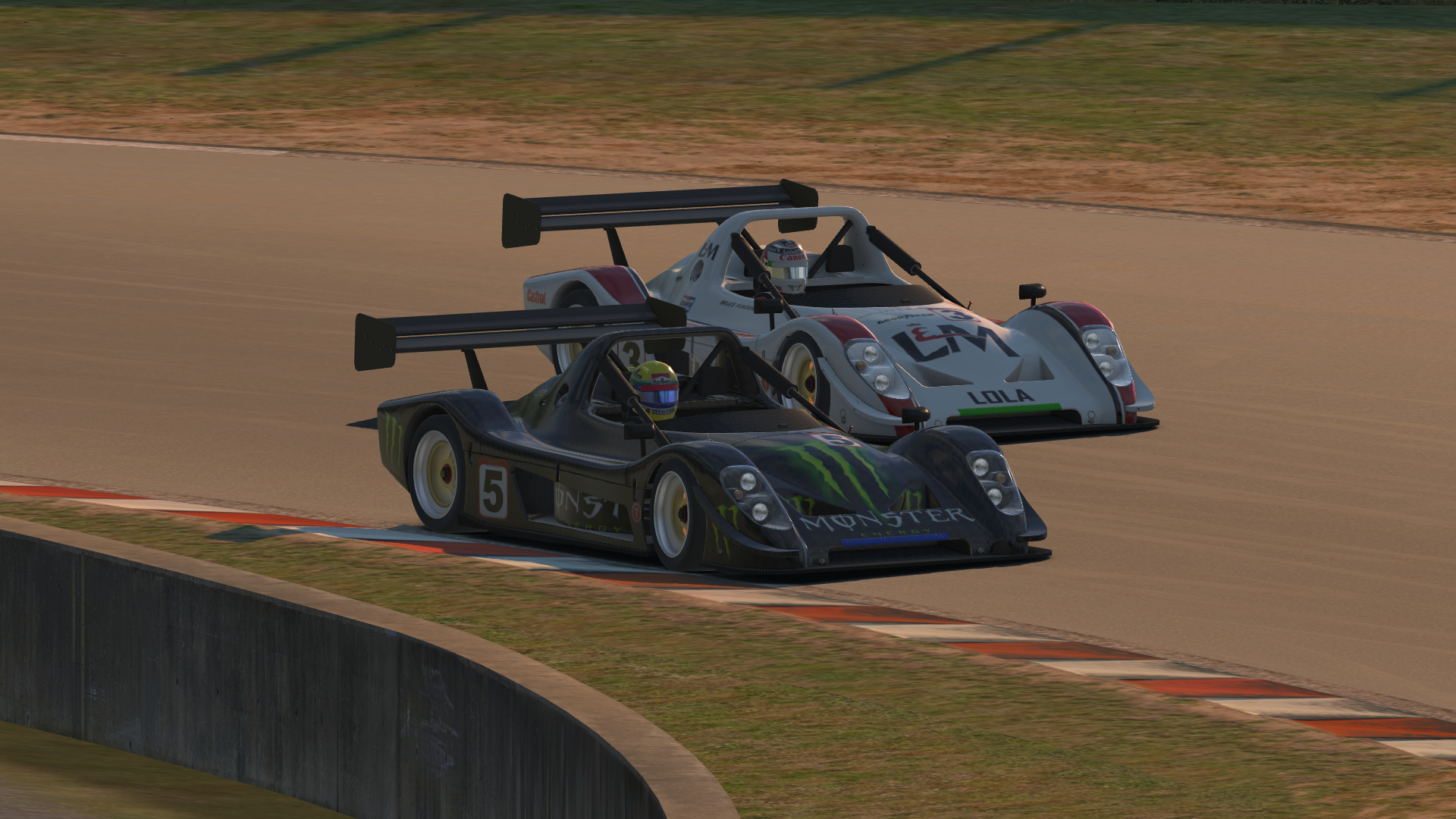
A Radical battle for third place.
The Shakedown
Wherever — and whoever — they are, they’re missing out on the car with perhaps the best personality in iRacing. And I say that as someone who had dreaded driving it in recent weeks. I feared that a prototype powered by a motorcycle engine — one that sounds amazing from the trackside cameras, by the way — wouldn’t exactly mesh with my decidedly closed-cockpit, V8-loving driving style.
After running some laps in it, I realized that the Radical probably suits me better than the Pro Mazda. Last week at Brands Hatch, I could brake late and turn on a dime in the Mazda, barely feeling anything from the car unless it suddenly decided to spin. By comparison, the Radical offers a bit more resistance, and not in a bad way.
When cornering, the steering wheel feels heavier but not as though the car is tight. I could feel it responding to my inputs and the bumps on the track, which helps make it a very lively car to drive.
It can even be exhausting when pushing hard, which is about the last sensation I expected from a typically on-a-rail prototype. Clearly, my preconceived notions about this car and why I thought I’d hate it were incorrect.
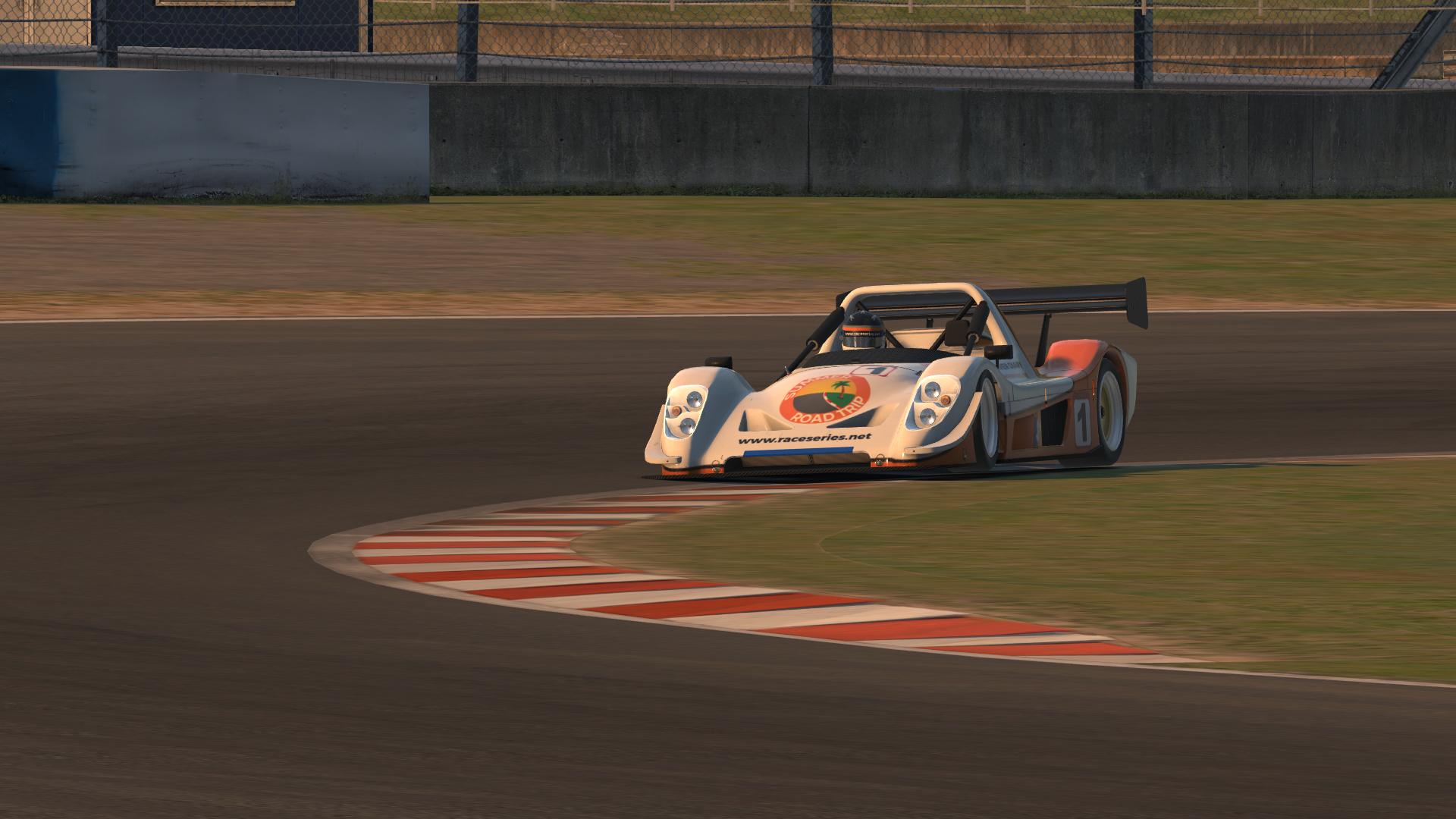
The Radical handles kerbs well, and you feel the impact through the steering wheel.
Likewise, I expected its setup options would be a complicated set of doodads and gizmos that a GT driver wouldn’t understand. But instead, I found the same tire, suspension, and rollbar adjustments I’m used to, as well as one of my favorite adjustment tools — rear differential settings.
The only thing that seemed strange to me was the high starting tire pressures. I’m used to hot pressures in the 155 to 160 kPa range, but in the Radical, those are the typical cold pressures. As the Radical’s pressures built up from there, I worried that they’d give the driving-on-basketballs feeling that I hate so much, but I never noticed that, even on a relatively warm track.
Somehow, the car that at first seemed so foreign felt fairly comfortable. It was even — dare I say it and lose my GT cred — fun. All I needed next was a chance to race it.
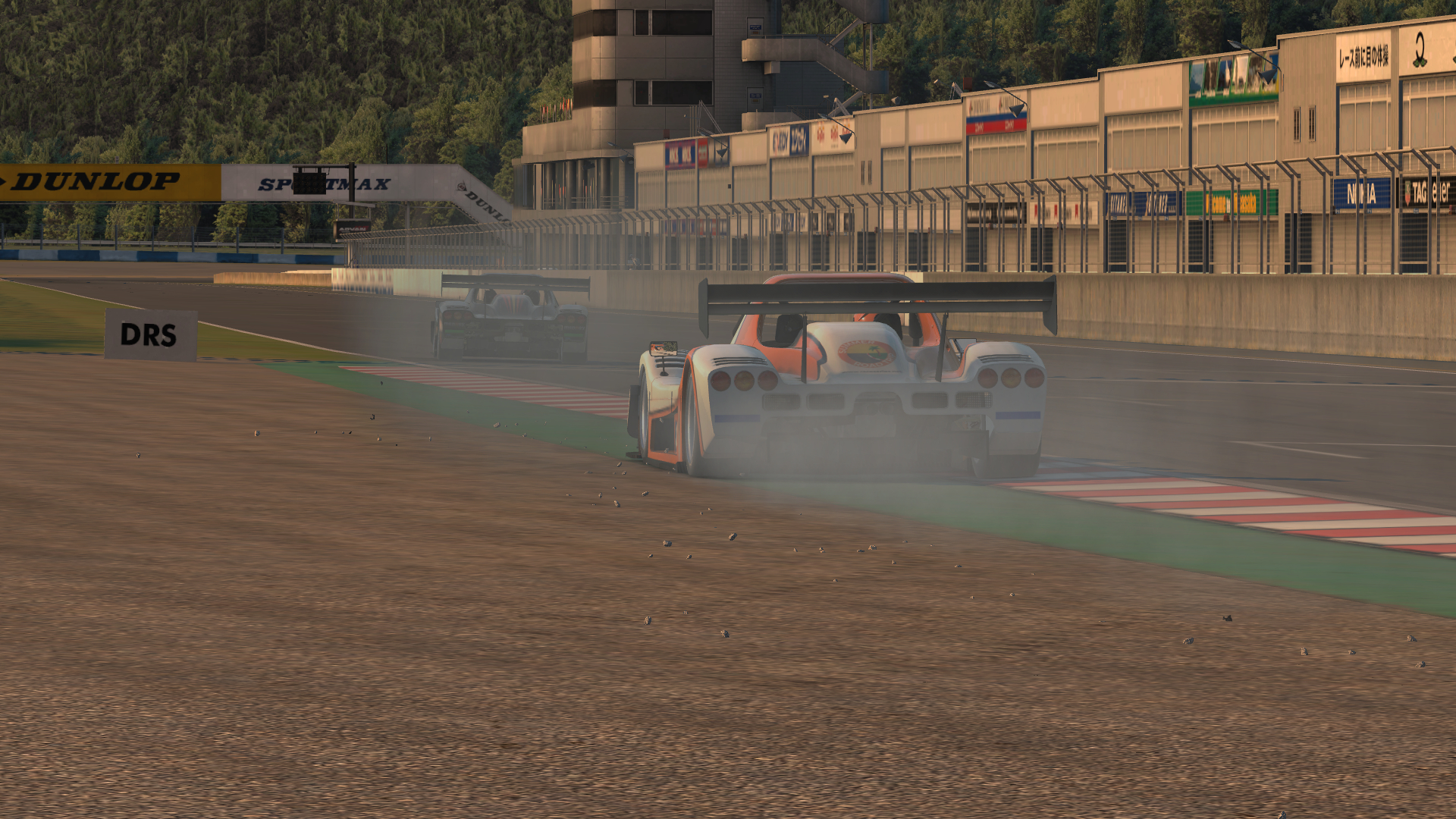
Pushing hard and scattering gravel exiting the final corner.
A Surprising Showing
In reviewing the season so far, I saw that the timeslots most likely to go official were on Tuesday morning and Friday afternoon, which tended to attract loyal groups of a half-dozen or so Aussies and Brits, respectively.
Unfortunately as an American, neither timeslot was ideal for me, as they essentially bookended my work day. But afraid of not seeing any racing action all week, I headed home early on Friday in time for the 3 pm EDT race. It would be my only chance to race the Radical, so I needed to make it count.
Nine drivers including myself showed up, making it the more popular of the two official races last week. There was a clear spread in speed among us, with nearly three seconds covering the field in qualifying.
I gridded in second place but faced a tough task in keeping up with the polesitter, whose setup (with minor modifications) I was using for the race. Surely I couldn’t outrun him using his own equipment, right?
Before I could test my race pace against his, I had to get past the standing start. With memories of my struggles in the V8 flashing through my mind, I made a clean but somewhat conservative start and held my position into the first turn.
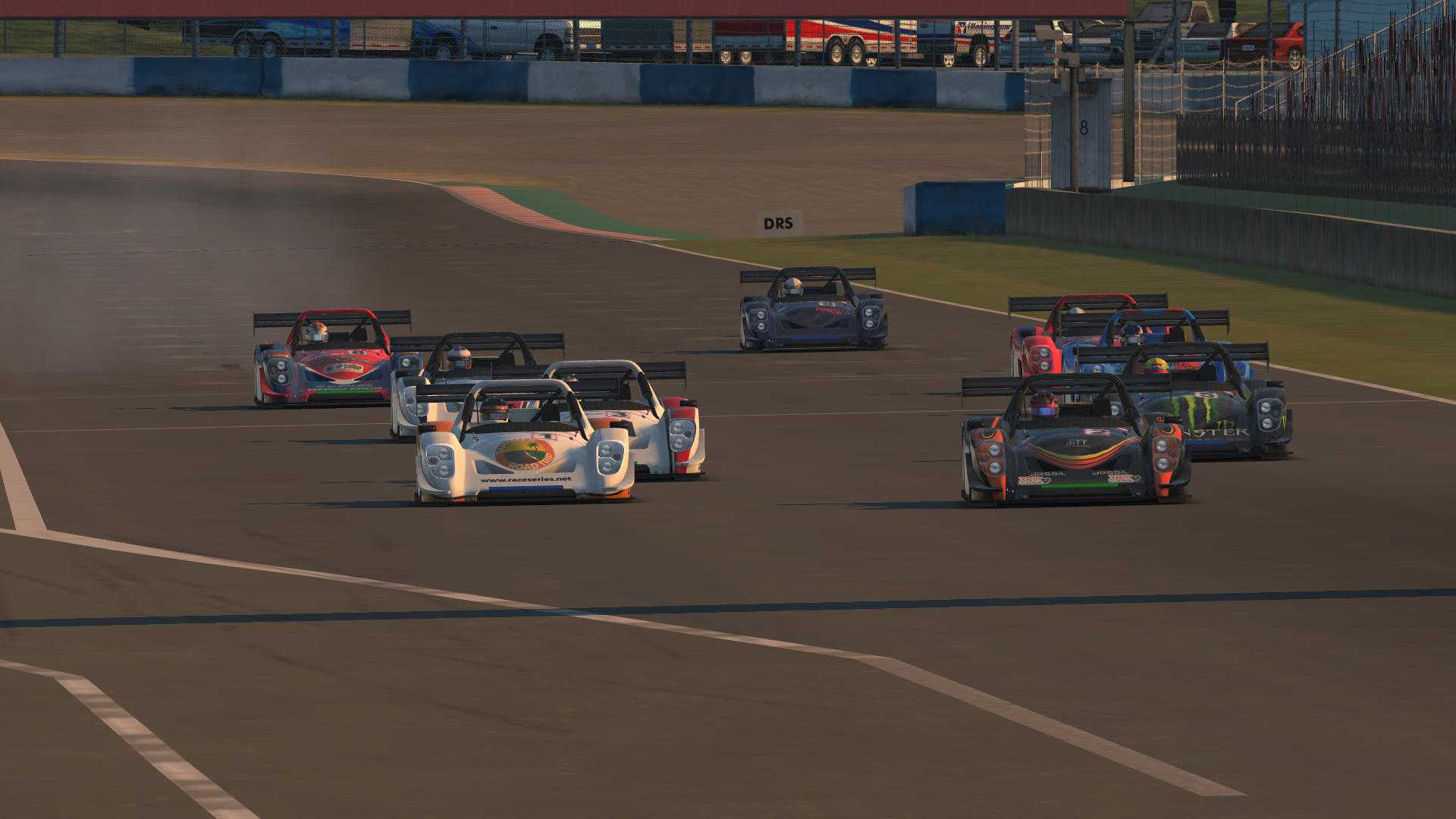
The nine-car field rolls off the grid at Okayama.
During the next few laps, the leader slowly pulled away while I gapped the two cars battling behind me. Although it appeared that I wouldn’t be battling anyone all race, I was just thrilled to be competitive and within a few tenths of the leaders’ lap times.
After about eight laps, though, the situation began to turn in my favor. I was suddenly gaining ground on the leader, often by 2 or 3 tenths per lap. I figured he was taking it easy or even purposefully slowing down to make it a closer race. But after I had cut his lead in half and was just over a second behind, I started thinking that my relative pace was real and maybe I had a chance, especially with lapped traffic just ahead of us.
Unfortunately for me, the traffic worked in his favor. He passed them on the frontstretch while I caught them through the first few turns and had to wait until the backstretch to get by. After that, his lead was back out to three seconds. With less than 10 laps to go, even closing in by three tenths per lap wouldn’t be good enough.
In the final laps, our times were similar, and I ended up 2.7 seconds behind at the finish. Ultimately, I doubt that I could have caught him even without the traffic. I was mainly just proud to have a respectable showing in what I figured would be my toughest car to adjust to all summer.
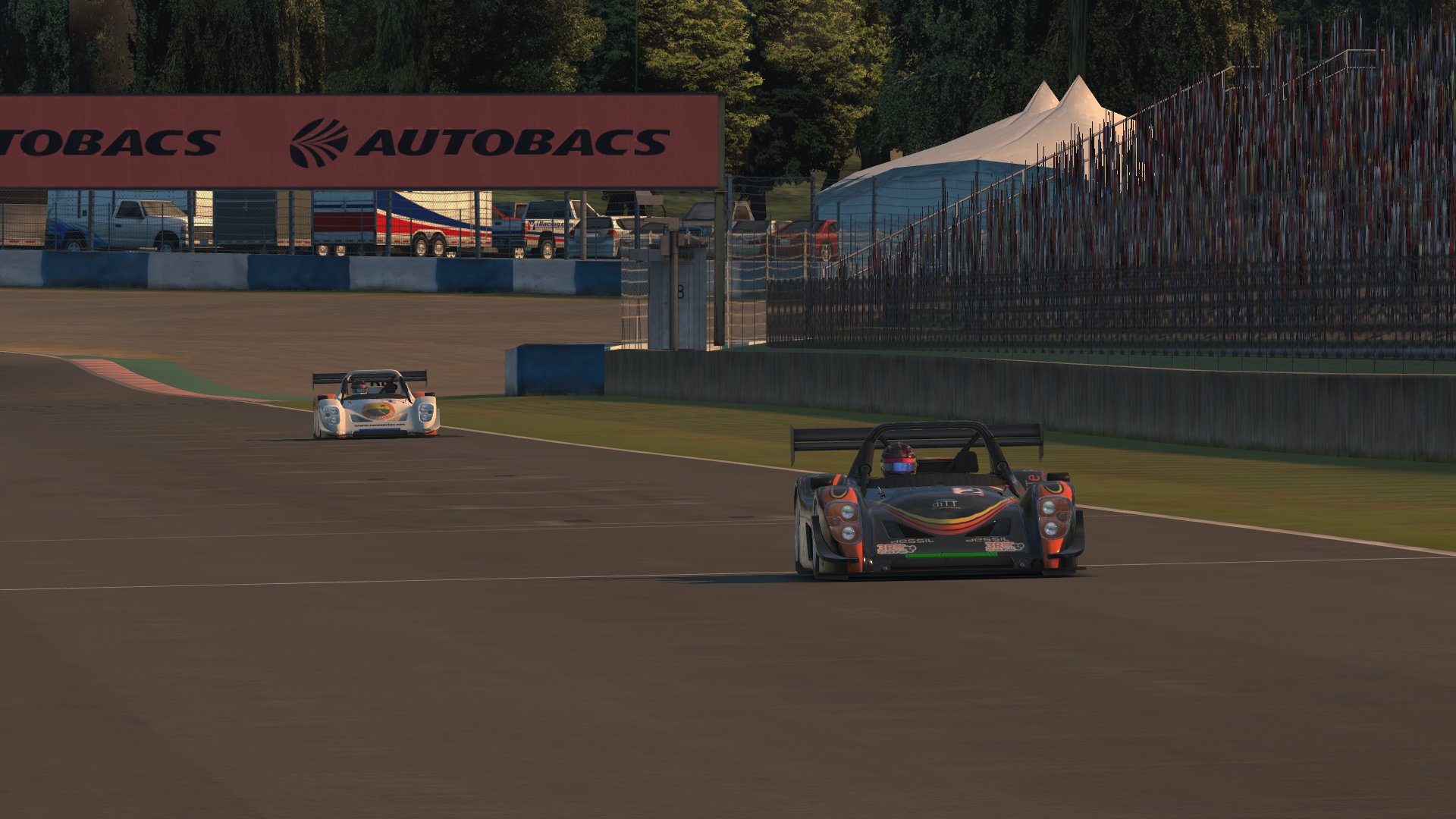
Finishing less than three seconds behind the winner in my first ever Radical race was a solid achievement.
Radical Racing Challenge
Friday, August 11 at 3:00 pm EDT • Strength of Field: 2160| Finish | Start | Interval | Laps Led | Fastest Lap | Incidents | Points | iRating | Safety Rating |
|---|---|---|---|---|---|---|---|---|
| 2 | 2 | -2.769 sec. | 0 | 48.954 | 1 | 105 | 4531 (+15) | A 3.41 (+0.09) |
Focused on the Future
As this season continues and I move on to different series, other new Radical drivers aren’t likely to materialize out of thin air. So what can be done to improve things for next season?
It’s been said that those who don’t learn from the past are doomed to repeat it. While the Radical’s participation numbers now are lower than ever, perhaps a study of the past can reveal some potential solutions for this struggling series.
After diving into the history of the Radical series, I felt a distinct sense of déjà vu. In the summer of 2013, the participation numbers were steadily dropping, and one week failed to have any official races.
Sound familiar?
Digging through the old forum posts from that time, drivers were celebrating a timeslot with 17 drivers.
Sound even more familiar?
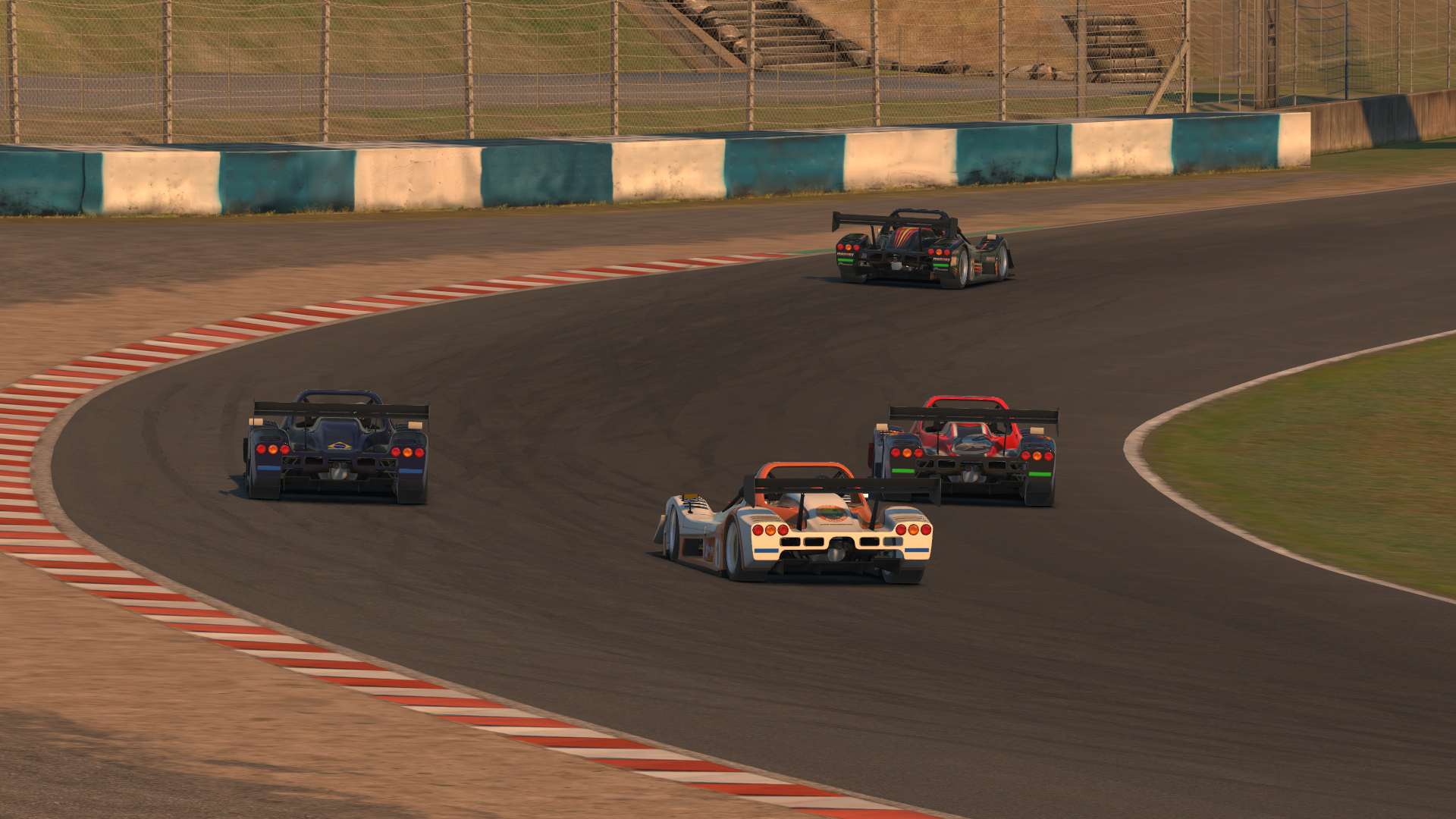
Working through traffic while the leader pulls away.
While the series probably seemed dead in the water by the end of that season, things turned around. The next season, participation increased almost eightfold — from 26 drivers per week to 229, and 130 total drivers to 1,017.
It wasn’t because of luck, though. Several key changes made at the behest of the community with cooperation from iRacing helped put a stop to the Radical’s skid.
First, it went from fixed to open setup, and rear wing adjustments were added to help tune the car to a drivers’ liking. For the setup-shy, some of the series’ best drivers created and shared stable setups each week.
Nowadays, the community is thinking along similar lines, potentially keeping the dive planes fixed on but leaving the other settings open to promote a higher-downforce and easier-to-drive setup.
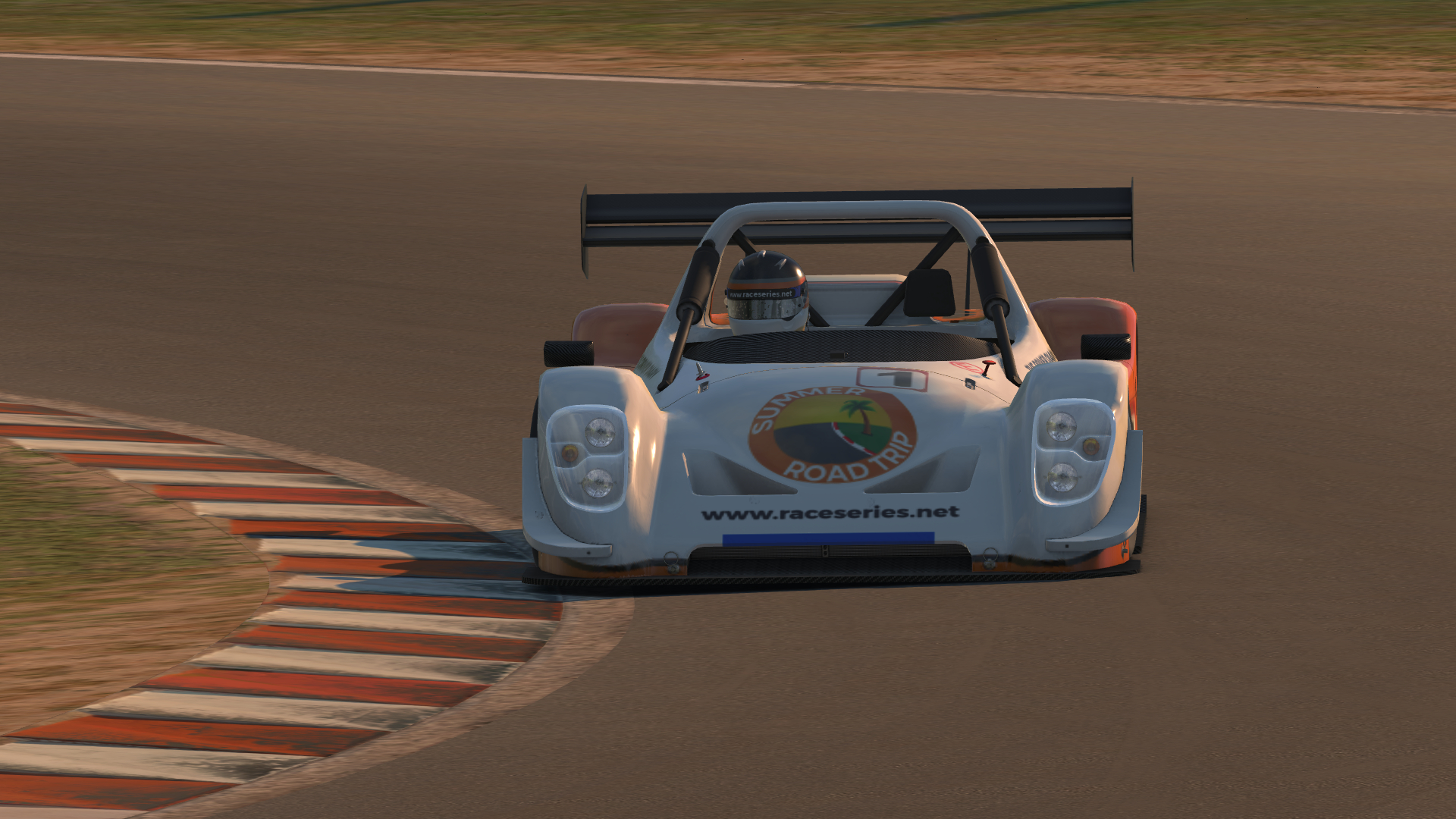
Dive planes have become a conversation piece within the Radical community.
For the fall of 2013, the schedule stuck primarily to popular tracks and 25-minute race lengths, both of which helped draw in more casual drivers.
Likewise, the community has suggested using popular tracks next season as well as static weather conditions in morning lighting to ensure the track stays cooler and grippier.
Finally, to whet the appetites of the iRacing community prior to 2013 season 3, the Radical was given its own unofficial week 13 series, which surely introduced and encouraged new drivers to try the car.
I haven’t seen that as an active point of discussion this season, but it should be. It worked for the Radical before and it has worked for other series as well. I would have never driven the asphalt sprint car if not for its appearance in a week-13 series one year ago. Those fun, unofficial races helped convert me and several others to full-time drivers in the official sprint car series.
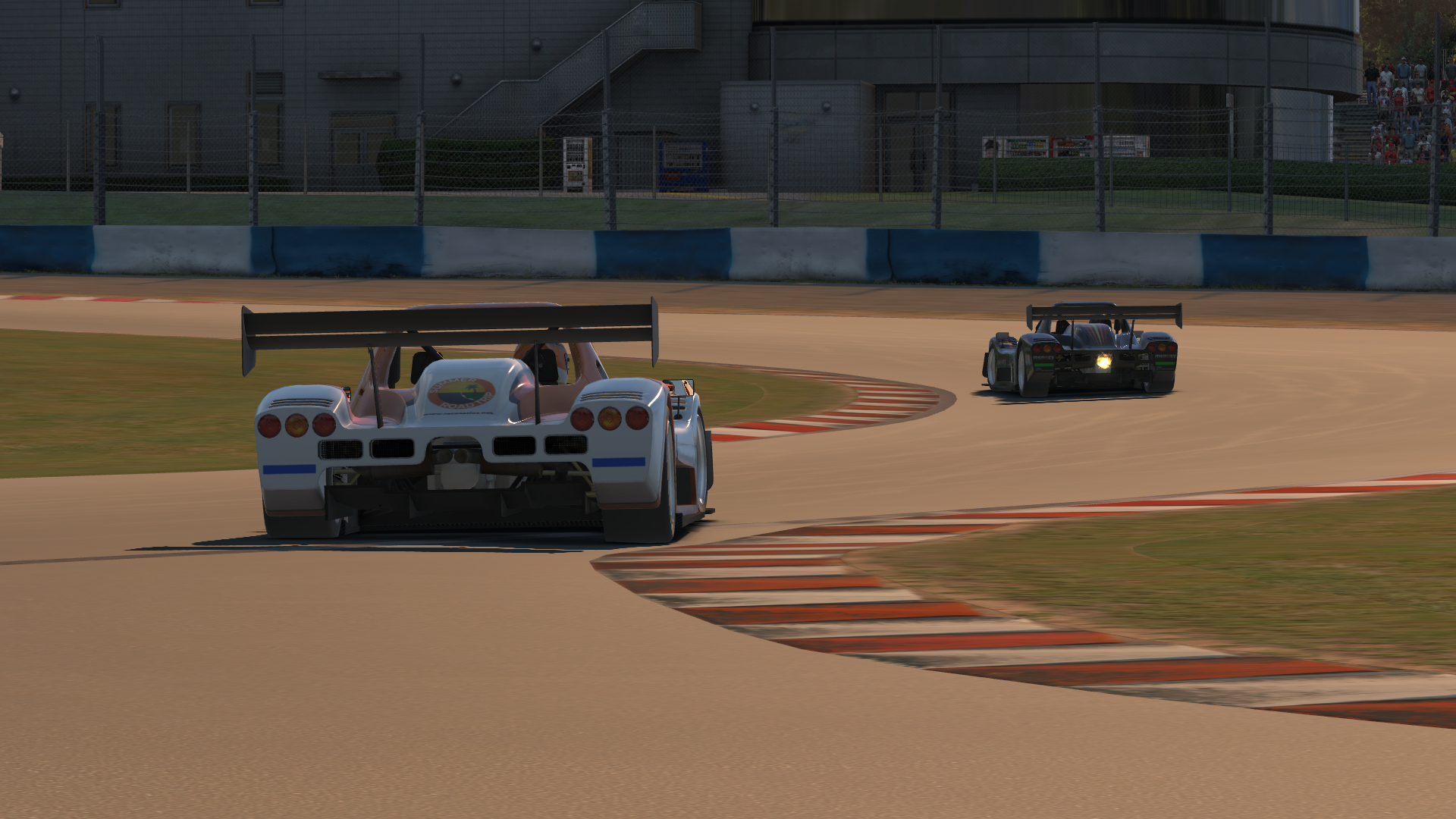
Slicing through the esses on lap 15.
Compared to the wild beast that is the sprint car, the Radical should be more accessible and an easier sell for new drivers. And just imagine how exciting and intense it would be to drive in large fields during short races. The now-surging IMSA series would seem like a Sunday drive by comparison.
Even running one race in the Radical has made me much more likely to drive this car in the future. Of course, it would be easier with at least one America-friendly timeslot on weekdays, but as with the V8 Supercar series, I imagine that would fall into place with some rekindled interest on this side of the pond.
But I alone can’t make that happen. As a lone driver and blogger, I’m far from the medic needed to revive the Radical. I just hope I’m not the coroner filling out its death certificate, either.